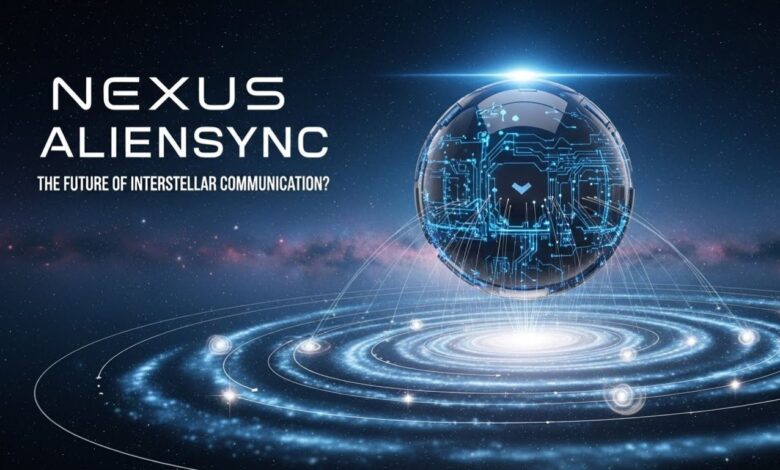Nexus Aliensync: The Future of Interstellar Communication?

Picture this: a future where humans can communicate effortlessly with extraterrestrial civilizations across vast cosmic distances. The idea might sound like something out of science fiction, but recent advancements in technology bring us closer to making it a reality. Enter Nexus Aliensync—a groundbreaking initiative that could redefine interstellar communication as we know it. This innovative system promises not just to connect us to the unknown universe but also to transform our understanding of life beyond Earth. Curious about what Nexus Aliensync is and how it will shape our galactic interactions? Let’s dive into this fascinating topic and discover the potential that lies ahead.
What is Nexus Aliensync?
Nexus Aliensync is an innovative communication system designed to bridge the gap between humanity and extraterrestrial civilizations. This groundbreaking technology aims to facilitate meaningful exchanges across vast interstellar distances.
At its core, Nexus Aliensync utilizes advanced algorithms and artificial intelligence. These components work together to decipher signals that may originate from other intelligent life forms. The goal is to create a seamless channel for dialogue.
Unlike traditional radio waves or satellite communications, Nexus Aliensync prioritizes speed and clarity. It adapts in real-time to varying cosmic conditions, ensuring reliable contact no matter the circumstances.
The potential of this system extends far beyond simple messaging. By promoting understanding between species, it could foster collaboration on unprecedented scales—ushering in a new era of exploration and knowledge-sharing among the stars.
The History of Interstellar Communication
The quest for interstellar communication dates back centuries. Ancient civilizations gazed at the stars, imagining messages from other worlds. They crafted myths and legends that hinted at extraterrestrial beings.
In the 20th century, humanity took a bold step with radio waves. The first deliberate transmission into space occurred in 1974 from Arecibo Observatory. This signal aimed to reach potential extraterrestrial life near M13, showcasing human ingenuity.
With each technological advancement, our understanding deepened. Researchers began using lasers as a method of sending information across vast distances. The emergence of digital communication opened new avenues for exploration.
Today, projects like SETI actively search for signals from intelligent life forms beyond Earth. As we expand our horizons, the dream of connecting with distant civilizations grows stronger than ever before. Exciting possibilities await us in this uncharted territory.
The Advancements in Communication Technology
Communication technology has evolved dramatically over the past few decades. The rise of the internet revolutionized how we share information. Today, messages travel instantly across vast distances.
Satellite technology took communication a step further. It enabled global connectivity, allowing for real-time conversations anywhere on Earth. This shift laid the groundwork for exploring interstellar communication.
Artificial intelligence also plays a pivotal role in advancements today. AI algorithms enhance data compression and error correction, making transmissions more efficient than ever before.
Quantum communication is another exciting frontier. Utilizing quantum entanglement could allow secure communications that are nearly impossible to intercept.
These innovations pave the way for concepts like Nexus Aliensync, where seamless interaction might extend beyond our planet’s boundaries. Each breakthrough brings us closer to understanding and connecting with potential life forms in the universe.
How Does Nexus Aliensync Work?
Nexus Aliensync operates on a groundbreaking principle that harnesses quantum entanglement. This allows for instantaneous communication across vast interstellar distances.
At its core, the system uses sophisticated algorithms to encode messages into particles. These particles are then transmitted through space, maintaining their integrity despite the miles they travel.
Once received, the entangled partner particle decodes the message in real-time. This process eliminates traditional lag time associated with radio waves and other forms of communication.
The technology is designed to adapt dynamically based on environmental conditions. By analyzing cosmic background radiation and interference patterns, Nexus Aliensync can optimize transmission paths efficiently.
Moreover, it incorporates advanced error-correcting codes to ensure clarity and security during exchanges. As a result, users experience seamless conversations without losing vital information along the way.
Potential Benefits of Nexus Aliensync
Nexus Aliensync offers a groundbreaking approach to interstellar communication. One of its primary benefits is the potential for real-time dialogue with extraterrestrial civilizations. This could reshape our understanding of the universe.
Enhanced data transmission capabilities mean we might receive vast amounts of information from distant worlds. Imagine deciphering ancient alien histories or technological secrets that could benefit humanity.
Moreover, Nexus Aliensync could foster collaboration among Earth’s nations, uniting them in a shared mission for exploration and understanding. Such cooperation can lead to advancements in science and technology.
Additionally, it opens doors to cultural exchanges that enrich human society. The insights gained could inspire art, philosophy, and new perspectives on life itself.
The possibilities are as endless as the cosmos when it comes to what we may learn through this innovative communication system.
Ethical Considerations and Concerns
As we delve into the realm of Nexus Aliensync, ethical considerations come to the forefront. The potential for interstellar communication raises important questions about consent. Should humanity reach out to unknown civilizations without their awareness or agreement?
Moreover, there’s the risk of cultural contamination. An advanced civilization may possess knowledge and perspectives that could be disrupted by human contact. Preserving their way of life should be a priority.
Security concerns also arise in this context. What happens if malicious entities gain access to Nexus Aliensync? Protecting sensitive data is crucial as we explore new frontiers.
Resource allocation poses a dilemma. Investing heavily in interstellar communication might divert funds from pressing terrestrial issues like poverty and climate change. Balancing ambition with responsibility is essential as we navigate these uncharted waters.
Future Implications and Possibilities
The future implications of Nexus Aliensync are vast and intriguing. Imagine a universe where communication with extraterrestrial civilizations is not just a dream, but a reality. This technology could bridge gaps between species, fostering understanding across galaxies.
Nexus Aliensync may also revolutionize how we perceive our place in the cosmos. By opening channels to alien societies, humanity might gain insights into advanced technologies or philosophies that challenge our current paradigms.
Moreover, this interstellar connection could spur innovation on Earth. Ideas exchanged from distant worlds may inspire breakthroughs in science and art, enriching human culture profoundly.
However, the potential for unforeseen consequences looms large. Establishing contact might introduce risks related to misinformation or cultural contamination, raising questions of responsibility and ethics in these new communications.
As we explore these possibilities further, it becomes clear that each step forward brings both excitement and caution into the realm of cosmic dialogue.
Is Nexus Aliensync the Future?
Nexus Aliensync stands at the forefront of interstellar communication technology. Its innovative design promises to bridge vast distances across space.
Imagine a world where messages travel faster than light, connecting civilizations previously thought unreachable. The potential for knowledge exchange is staggering.
However, the question remains: will it truly revolutionize how we communicate beyond our planet? Scientists and enthusiasts alike are watching closely as developments unfold.
The excitement is palpable. Yet there are hurdles to overcome—technical challenges that could impede progress.
Moreover, public perception plays a crucial role in its adoption. Will humanity embrace such groundbreaking technology?
As research continues, Nexus Aliensync may redefine not only communication but also our understanding of existence itself. Exploring new frontiers could lead us closer to discovering intelligent life forms and fostering relationships that transcend species barriers.
Conclusion
The realm of interstellar communication is on the brink of a revolutionary transformation with Nexus Aliensync. This groundbreaking technology promises to bridge the vast expanses of space, fostering connections between Earth and potential extraterrestrial civilizations.
As we embrace advancements in communication technology, Nexus Aliensync stands out as a beacon of hope. Its innovative design not only enhances our ability to send messages across light-years but also opens doors to understanding intelligent life beyond our planet. The benefits it offers could reshape our entire approach to cosmic exploration.
However, ethical considerations loom large. Questions about privacy, consent from other civilizations, and the implications of contact must be navigated carefully. As humanity steps closer towards making first contact, these concerns cannot be overlooked.
Looking ahead, Nexus Aliensync holds immense potential for collaborative projects that transcend planetary boundaries. Imagine sharing knowledge and culture with beings from distant galaxies. The possibilities are exhilarating yet daunting.
Is this technology truly the future? It seems poised at the intersection of innovation and curiosity—a testament to what can happen when humanity dares to reach for the stars while maintaining an awareness of its responsibilities along the way.



